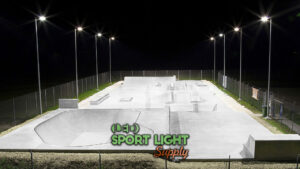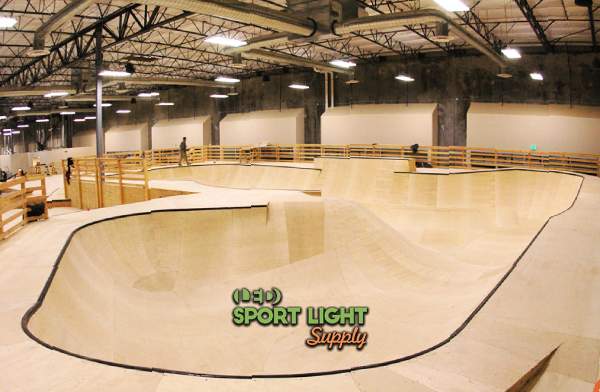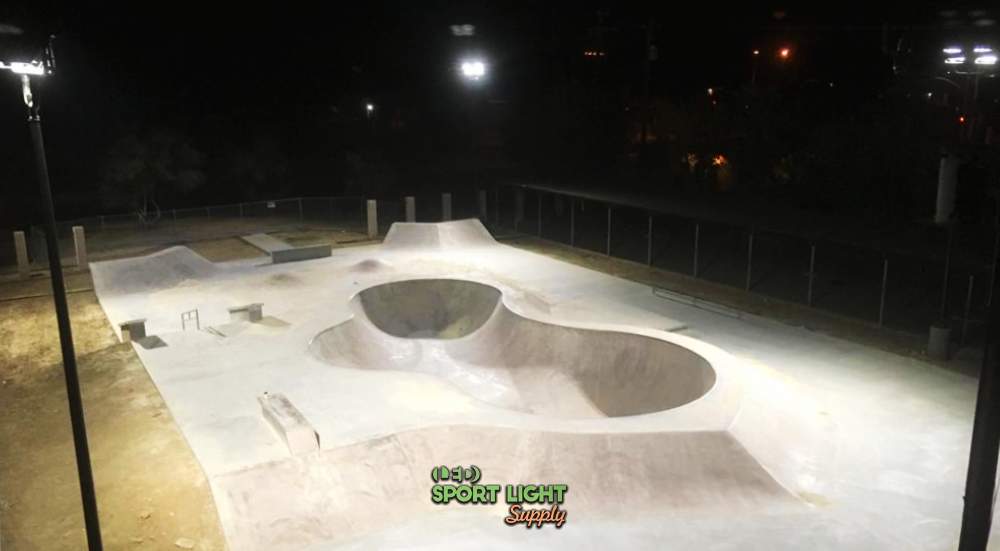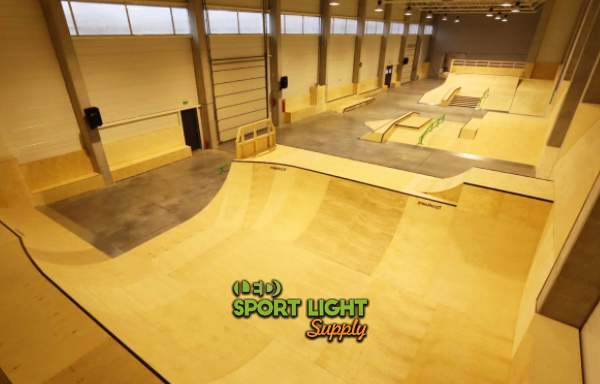
Skate parks are dynamic environments that thrive on the energy and creativity of skaters. To maximize the experience, proper lighting plays a key role, not only by enhancing visibility and safety but also by creating an inviting ambiance that encourages skaters to return. Whether it’s for day-to-day use or evening sessions, a well-illuminated skate park significantly influences how skaters engage with the space, allowing them to perform tricks and navigate obstacles confidently. This makes the choice of lighting systems a crucial consideration in skate park design.
Table of Contents
Toggle The effectiveness of a skate park depends largely on how well skaters can see and interact with the various elements within the space. Proper lighting ensures that obstacles like ramps, rails, and bowls are clearly visible, reducing the risk of accidents. Skaters often perform complex maneuvers at high speeds, making visibility paramount. Beyond safety, lighting also enhances the overall aesthetic, making the park more appealing and enjoyable for both skaters and spectators. Strategic lighting can highlight features, adding visual interest to the park during evening hours and making it a focal point in the community.
The effectiveness of a skate park depends largely on how well skaters can see and interact with the various elements within the space. Proper lighting ensures that obstacles like ramps, rails, and bowls are clearly visible, reducing the risk of accidents. Skaters often perform complex maneuvers at high speeds, making visibility paramount. Beyond safety, lighting also enhances the overall aesthetic, making the park more appealing and enjoyable for both skaters and spectators. Strategic lighting can highlight features, adding visual interest to the park during evening hours and making it a focal point in the community.
Among the range of lighting technologies available, LED lights have become the preferred option for outdoor skate parks. One of their most significant benefits is their remarkable energy efficiency. LEDs use a fraction of the power that traditional lighting systems, such as halogen or fluorescent bulbs, require. This reduction in energy consumption translates to lower electricity bills, making LEDs a cost-effective choice for municipalities and private owners. Additionally, their lower power usage aligns with sustainability goals, reducing the environmental impact of running a skate park.
Another advantage of LED lighting is its superior illumination quality. LEDs have high color rendering indexes (CRI), which means they can produce light that closely resembles natural sunlight. This characteristic is particularly beneficial in a skate park setting, where accurate color perception is crucial for skaters to judge distances and navigate features safely. The vibrant, true-to-life colors offered by LEDs also enhance the park’s atmosphere, making the space more visually engaging during nighttime use.
Skate parks are exposed to the elements year-round, whether in harsh sun, heavy rain, or freezing temperatures. LED lights are specifically designed to withstand these conditions. Unlike traditional lighting options, LEDs are built with robust materials that resist moisture, dust, and temperature fluctuations. Additionally, LEDs are highly resistant to shocks and vibrations, making them well-suited to environments where there is constant movement and impact, such as a skate park. This durability ensures that the lighting system remains functional and reliable, reducing the frequency of replacements and repairs.

| Area of the Skate Park | Recommended Lux Level | Purpose |
|---|---|---|
| General Areas (non-high activity) | 100 lux | Provides basic illumination for safety and general visibility in low-activity zones. |
| High-Activity Zones (e.g., bowls, rail sections) | 300 lux | Ensures adequate lighting for complex tricks, fast movements, and areas with higher activity levels. |
| Surrounding Flat Areas | 150 lux | Offers sufficient lighting for skaters to navigate the space comfortably while maintaining focus on key features. |
| Obstacles and Ramps | 200–300 lux | Focused lighting to eliminate shadows and provide clear visibility during trick execution on ramps and obstacles. |
The right level of illumination is key to creating a safe and enjoyable environment for skaters. Industry standards suggest that general areas of a skate park should be lit to a minimum of 100 lux. In zones where skaters perform more advanced tricks or where high-speed movements occur, lighting levels of up to 300 lux are recommended. This range provides the necessary visibility for skaters to react quickly to obstacles and changes in terrain.
Different areas of the skate park can benefit from varying levels of illumination. For instance, the central bowl or the rail sections can be illuminated to higher lux levels, around 300 lux, while surrounding flat areas can be maintained at approximately 150 lux. This approach not only ensures that skaters have adequate visibility in high-activity zones but also creates a sense of focus on the park’s key features. By using a combination of lighting levels, the park can maintain a balanced look while reducing unnecessary energy consumption.
 A thoughtfully designed lighting layout is essential for achieving even coverage and minimizing shadows. A combination of overhead lights mounted on tall poles and angled fixtures closer to the ground provides comprehensive illumination. Overhead lights ensure general visibility, while angled lights are used to highlight specific features like ramps and rails. This dual approach reduces the risk of shadows that could obscure obstacles, thereby enhancing the safety and usability of the park.
A thoughtfully designed lighting layout is essential for achieving even coverage and minimizing shadows. A combination of overhead lights mounted on tall poles and angled fixtures closer to the ground provides comprehensive illumination. Overhead lights ensure general visibility, while angled lights are used to highlight specific features like ramps and rails. This dual approach reduces the risk of shadows that could obscure obstacles, thereby enhancing the safety and usability of the park.
The placement of lighting fixtures significantly impacts their effectiveness. High-mast poles positioned around the perimeter of the park can cast light evenly across the entire area. Lower, adjustable fixtures placed closer to obstacles help to illuminate critical areas where skaters need more precise visibility. By focusing additional light on ramps and bowls, shadows are minimized, allowing skaters to gauge distances accurately when performing tricks. Properly positioned lights also enhance the visual appeal of the park, making it more inviting during evening hours.
Outdoor skate parks face a variety of environmental challenges, from extreme heat in the summer to freezing conditions in the winter. LED lights are particularly well-suited for such environments because they can operate efficiently over a wide temperature range. Unlike traditional lighting systems that may fail in extreme weather, LEDs are designed with advanced thermal management systems that prevent overheating and ensure consistent performance. Their resistance to moisture and dust makes them an ideal choice for outdoor installations.
Skate parks located in areas with frequent rainfall or high humidity levels can experience issues with lighting equipment due to moisture exposure. LEDs are built with sealed housings that protect internal components from water ingress, ensuring reliable operation even during heavy rain. Additionally, their resistance to dust accumulation reduces the risk of overheating, contributing to a longer lifespan. This resilience makes LEDs a practical choice for skate parks that need to withstand various environmental conditions.
While LED lights are known for their durability and long lifespan, regular maintenance is still required to ensure optimal performance. The low-maintenance nature of LEDs, however, means that skate park operators can minimize the time and resources needed for upkeep. With lifespans that can exceed 150,000 hours, high-quality LEDs reduce the need for frequent replacements, lowering long-term maintenance costs.
To maintain a well-lit skate park, periodic inspections are recommended. These inspections should focus on checking for any damaged lights, cleaning fixtures to remove accumulated dirt, and addressing electrical components that may have worn over time. Ensuring that the lighting system is fully operational is crucial for the safety and enjoyment of park users. By proactively addressing maintenance needs, the longevity of the lighting system is extended, ensuring consistent illumination over the years.
LEDs have become the preferred choice for these spaces due to their energy efficiency, durability, and superior light quality. By selecting the right lighting levels, strategically placing fixtures, and using LED technology, skate parks can be designed to meet the needs of skaters while minimizing operational costs. Through thoughtful planning and regular maintenance, the lighting system can enhance the overall experience, making the park a vibrant and welcoming space for the community.
Drop us a line to receive a free lighting design